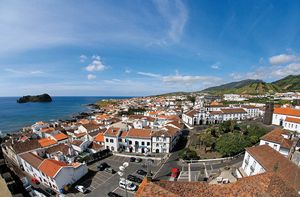
Vila Franca do Campo
Explore the first village, and the former capital of the São Miguel Island, Azores, Portugal
Vila Franca do Campo was the first village, and the capital of the Azorian island of São Miguel, until it succumbed to the 1522 earthquake and the eruption on Lago do Fogo in 1563; on top of that it was witness of how in the sea the fleet which demanded the rights of the prior of Crato that was defeated by the Spanish.
The city was rebuilt and nowadays is presented as a picturesque city in front of the famous Ilhéu da Vila Franca do Campo, the boiler of a little volcano which is used as a pool.
Vila Franca do Campo enjoys a rich built heritage, and counts with traditional pottery and various museological centres.
In the highest part of the city, besides the road, stand its main monuments. The first one you will find will be the Igreja de São Pedro Church, from the 18th century; not far, taking the seaside road, is located the potter workshops which currently preserve its handicraft production. here, in addition to see them in the middle of the work, you can buy some of its pieces.
The Olaria Museological Centre exhibits archeological findings and ancient furniture along with local handcrafted ceramic pieces.
Following the rua Teófilo de Braga you will arrive to the Igreja Matriz de São Miguel (Mother Church), rebuilt in 1522, with a sober facade, all of it in black basalt.
Adjacent to the hospital stands the Igreja da Misericórdia Church, 17th-18th centuries, preceded by a large stairway which counts with a gorgeous Baroque facade.
In front of the City Council, 18th century, you will find some bronze statues of Goçalo Vaz Botelho o Grande, founder of the city in 1444, and some beautiful fountains. Its beautiful facade with a high clock tower reminds of the Ponta Delgada one.
From the Rua Conego Sena Freitas you access a terrace, open to the sea, where stands the Ermita de Santa Catarina Shrine, of Baroque style, and the Henrique o Navegante Monument; if you look at the sea you will see the emblematic Ilhéu da Vila.
Towards the West you will find a black sand beach which extends to the projection which hosts the Castelinho das Taipas.
A little bit further from the top crowned by the Fortín do Tagarete (little fort) you will find the marina, a beach generated with white sand, and the Atlântico Splash, an amusing aquatic park.
It is also worthy to mention the São Francisco Convent, with its church which rooms have been turned into a hotel, and its vegetable garden in a public park; and the San André Convent, decorated with Baroque altars and 18th century tiles, in front of which is located the music box and the largo Bento de Gões.
On the other side of the street is the central headquarters of the Vila Franca do Campo Museum, which is hosted in a nineteenth-century solar. On its found are especially dedicated to the history of transport. Other museological centres located in Vila Franca do Campo are the Água d’Alto, with the hydro-electric centre da Praia, from 1911, and the Ribeira Seca, with the São José mill.
A compulsory tour is the one which takes you, for just 2€, to IIlhéu da Vila, a circular crater with 150 metres of diameter, belonging to a little coastal volcano, which has been prepared to become a natural warm water pool.
Another short and recommended tour is the one which goes from Santo André, which arrives to the Ermita de Nossa Senhora da Paz Hermitage, from the 18th century, after going beside the banana plantation and estufas ananase. The walk lasts for around 2 kilometres, with some slopes.
Around 6 kilometres Northeast from the city, on the road which goes to Pico do Ferro, is worth stopping the car and visiting the Congro Lake. There is a pedestrian route which goes towards a crossroad where you should turn right until you pass by shepherd’s hut.
The main festivities celebrated in this city are the Santo Cristo dos Milagros and São Miguel Arcanjo, both on the month of May. On the Sunday following the 8th September takes place the Trabalho procession. Other popular festivities are the São João ones, in the 24th June), and the Bom Jesus da Pedra, the last Sunday of August.
Mapa Interactivo:
São Miguel Island
What to see:
- Ponta Delgada
- Jardim José do Canto Garden
- Igreja de São Roque (Mother Church)
- Sete Cidades
- Miradouro do Vista do Rei Overlook
- Miradouro da Ponta do Sossego Lookout
- Miradouro Pico do Ferro Lookout
- Ribeira Grande
- Miradouro de Santa Iria Lookout
- Lagoa do Fogo
- Caldeira Velha
- Paços do Concelho (Ribeira Grande)
- Nordeste
- Mosteiros
- Vila Franca do Campo
- Ilhéu da Vila Franca do Campo
- Praia Agua d’Alto Beach
- Furnas
- Lagoa das Furnas
- Capelas
- Terra Nostra Botanical Garden
Why "Portugal Travel"?
Portugal Travel is an organization of Portuguese agencies whose objectives are:
- ✓ To make Portugal, its culture and its heritage known.
- ✓ To promote sustainable tourism.
In collaboration with:
Escola Superior de Hotelaria e Turismo do Estoril
Turismo de Portugal
Copyright PortugalTravel.org © - All rights reserved.



